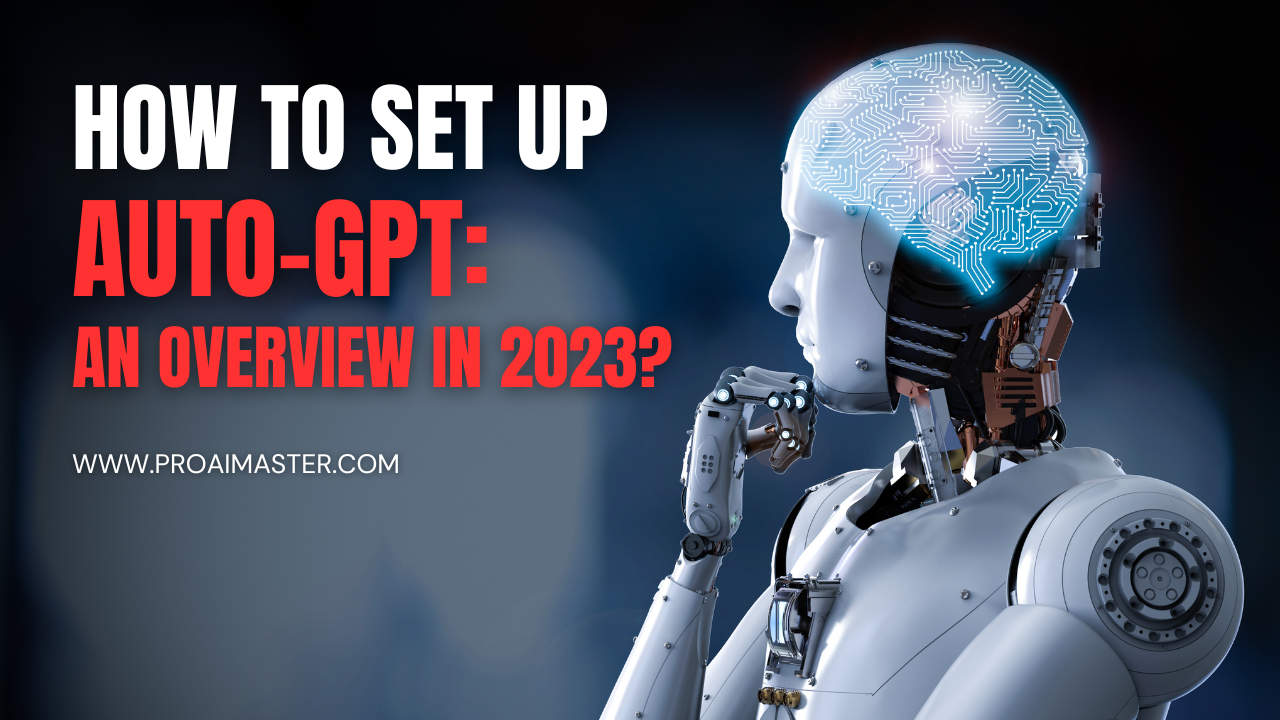How to Set Up Auto-GPT: An Overview In 2023? Setting up Auto-GPT can revolutionize the way you approach various tasks by automating the generation of human-like text.
Auto-GPT, powered by artificial intelligence, is a state-of-the-art language model that can generate coherent and contextually relevant responses based on prompts. This article will provide a comprehensive overview of how to set up Auto-GPT and leverage its capabilities to enhance productivity and creativity.
Understanding Auto-GPT: A Game-Changer in AI

Auto-GPT, short for Automatic Generative Pre-trained Transformer, is an advanced language model that employs deep learning algorithms to generate text based on provided prompts.
Developed by OpenAI, Auto-GPT is based on the GPT-3.5 architecture, making it one of the most powerful and versatile language models available. Its ability to mimic human-like responses has immense potential in various domains, including content creation, customer support, programming assistance, and more.
Choosing the Right Platform for Auto-GPT
Before diving into the setup process, it’s crucial to select a reliable platform that offers Auto-GPT capabilities. Several platforms provide easy-to-use interfaces for interacting with the model.
OpenAI offers a user-friendly API that allows developers to integrate Auto-GPT into their applications seamlessly. Other platforms like Hugging Face and AI Dungeon also provide access to Auto-GPT through their respective APIs. Evaluate the features and pricing options of each platform to determine the best fit for your requirements.
Setting Up Auto-GPT with OpenAI API

To set up Auto-GPT using the OpenAI API, follow these steps:
Register and Create an Account
Visit the OpenAI website and create an account to access the API. Follow the registration process and provide the necessary information to set up your account successfully.
Subscribe to the OpenAI API
Choose the pricing plan that suits your needs and subscribe to the OpenAI API. Make sure to review the pricing details and API usage limits to avoid any unexpected costs.
Generate API Keys
Once you’ve subscribed to the API, generate your API keys. These keys are essential for authenticating your requests to the OpenAI API. Keep them secure and avoid sharing them with unauthorized individuals.
Install the OpenAI Python Library
To interact with the OpenAI API, you’ll need to install the OpenAI Python library. Use the package manager of your choice (pip, conda, etc.) and install the library by running the relevant command.
Initialize the OpenAI Client
In your Python code, import the OpenAI library and initialize the OpenAI client using your generated API key. This step establishes the connection between your application and the Auto-GPT model.
Formulate Prompts and Make API Requests
To generate text using Auto-GPT, construct appropriate prompts that specify the desired output or context. Utilize the OpenAI client’s API methods, such as openai.Completion.create(), to make requests and receive responses from the Auto-GPT model.
Leveraging Auto-GPT for Various Use Cases
Once you have set up Auto-GPT, explore the multitude of possibilities it offers across different applications:
Content Creation and Writing Assistance
Auto-GPT can be an invaluable tool for content creators, writers, and bloggers. Use it to generate engaging blog post ideas, draft compelling introductions, or overcome writer’s block by obtaining suggestions for the next sentence or paragraph. Auto-GPT’s creative text generation capabilities can enhance productivity and inspire fresh ideas.
Customer Support and Chatbots
Integrate Auto-GPT into your customer support system or chatbot to automate responses to common queries.
With proper training and prompt formulation, you can provide accurate and helpful information to users, freeing up valuable human resources for more complex tasks.
Programming Assistance
Auto-GPT can assist developers by providing code examples, suggesting improvements, or explaining complex programming concepts.
By leveraging Auto-GPT’s vast knowledge and understanding of programming languages, developers can speed up their workflow and overcome coding challenges more efficiently.
Language Translation and Summarization
Utilize Auto-GPT’s language capabilities for tasks such as translation and summarization. Generate translations of sentences or paragraphs in various languages or summarize lengthy texts into concise and informative snippets.
Fine-tuning Auto-GPT for Specific Tasks
While the default version of Auto-GPT provides impressive text generation capabilities, you can further optimize its performance for specific tasks through fine-tuning.
Fine-tuning involves training the model on a custom dataset to align it more closely with your specific use case. OpenAI provides guidelines and resources for fine-tuning Auto-GPT, allowing you to tailor the model’s output according to your domain-specific requirements.
Data Privacy and Ethical Considerations

When setting up Auto-GPT, it is essential to consider data privacy and ethical implications. As Auto-GPT learns from vast amounts of text data, it is crucial to ensure that the prompts and data you provide align with ethical guidelines.
Avoid using or prompting the model to generate content that promotes hate speech, misinformation, or other harmful material. OpenAI provides guidelines and policies to ensure responsible usage of their models, and it is important to adhere to them.
Monitoring and Refining Auto-GPT’s Output
While Auto-GPT is incredibly powerful, it is not infallible. It is essential to monitor and review the generated output to ensure its accuracy and relevance.
Implementing a feedback loop where human reviewers evaluate and provide feedback on the generated content helps refine the model’s performance over time. Continuously iterating and incorporating user feedback will improve the quality and reliability of the generated text.
Balancing Automation and Human Intervention
While Auto-GPT automates text generation, it is important to find the right balance between automation and human intervention. Certain tasks may still require human input, creativity, and critical thinking.
Understanding the limitations of Auto-GPT and identifying areas where human expertise is indispensable ensures that the generated content maintains high standards and aligns with the intended goals.
Ensuring Diversity and Avoiding Bias
Language models like Auto-GPT are trained on vast amounts of data, and biases present in the training data can be reflected in the generated output. It is crucial to be mindful of potential biases and take steps to mitigate them.
By using diverse training data and actively monitoring and addressing bias in the generated content, you can ensure that Auto-GPT produces inclusive and unbiased text.
Exploring Collaborative AI Applications

Auto-GPT can also be utilized in collaborative AI applications, where it works alongside humans to enhance creativity and problem-solving.
Combining human expertise with the vast knowledge and generative capabilities of Auto-GPT can lead to innovative solutions, creative brainstorming sessions, and improved decision-making processes.
Staying Updated with Auto-GPT Advancements
The field of AI and language models is rapidly evolving. Stay updated with the latest advancements in Auto-GPT and similar models to benefit from new features, improvements, and enhancements.
OpenAI and other platforms regularly release updates and advancements, and being aware of them can help you leverage the full potential of Auto-GPT.
Conclusion
Setting up Auto-GPT opens up a world of possibilities in terms of automating text generation and enhancing productivity. By understanding the setup process and leveraging the power of Auto-GPT, you can streamline content creation, improve customer support, assist in programming tasks, and much more.
Stay up-to-date with the advancements in AI and explore the endless opportunities that Auto-GPT and similar language models have to offer.
FAQs
Q1: What is Auto-GPT?
A1: Auto-GPT, or Automatic Generative Pre-trained Transformer, is an advanced language model developed by OpenAI. It utilizes deep learning algorithms to generate human-like text based on provided prompts.
Q2: How can Auto-GPT benefit me?
A2: Auto-GPT can benefit you by automating text generation, enhancing productivity, and providing assistance in various domains such as content creation, customer support, programming, language translation, and more.
Q3: Which platform should I choose for setting up Auto-GPT?
A3: Several platforms offer access to Auto-GPT, such as OpenAI API, Hugging Face, and AI Dungeon. Evaluate the features, pricing, and ease of integration of each platform to choose the one that best suits your needs.
Q4: What is fine-tuning, and should I consider it?
A4: Fine-tuning involves training the Auto-GPT model on a custom dataset to align it more closely with your specific use case. Consider fine-tuning if you require more tailored and optimized output for your particular tasks.
Q5: How can I ensure data privacy and ethical usage of Auto-GPT?
A5: When using Auto-GPT, ensure that the prompts and data you provide adhere to ethical guidelines and do not promote hate speech, misinformation, or other harmful content. Adhere to OpenAI’s guidelines and policies to ensure responsible usage.
Q6: Can I monitor and refine Auto-GPT’s output?
A6: Yes, it is crucial to monitor and review the generated output to ensure its accuracy and relevance. Implement a feedback loop where human reviewers evaluate the generated content and provide feedback to improve the model’s performance.
Q7: Is human intervention necessary when using Auto-GPT?
A7: While Auto-GPT automates text generation, certain tasks may still require human input, creativity, and critical thinking. Find the right balance between automation and human intervention to maintain high-quality output.
Q8: How can I address bias in Auto-GPT’s output?
A8: Language models can reflect biases present in the training data. Mitigate biases by using diverse training data and actively monitoring and addressing bias in the generated content to ensure inclusivity and avoid perpetuating stereotypes.
Q9: What are some collaborative AI applications for Auto-GPT?
A9: Auto-GPT can be utilized in collaborative AI applications where it works alongside humans to enhance creativity, problem-solving, brainstorming, and decision-making processes. It can provide valuable insights and assist in generating innovative solutions.
Q10: How can I stay updated with Auto-GPT advancements?
A10: Stay informed about the latest advancements in Auto-GPT by following OpenAI’s updates and announcements. Keep an eye on the latest research and advancements in the field of AI and language models to leverage the full potential of Auto-GPT.


